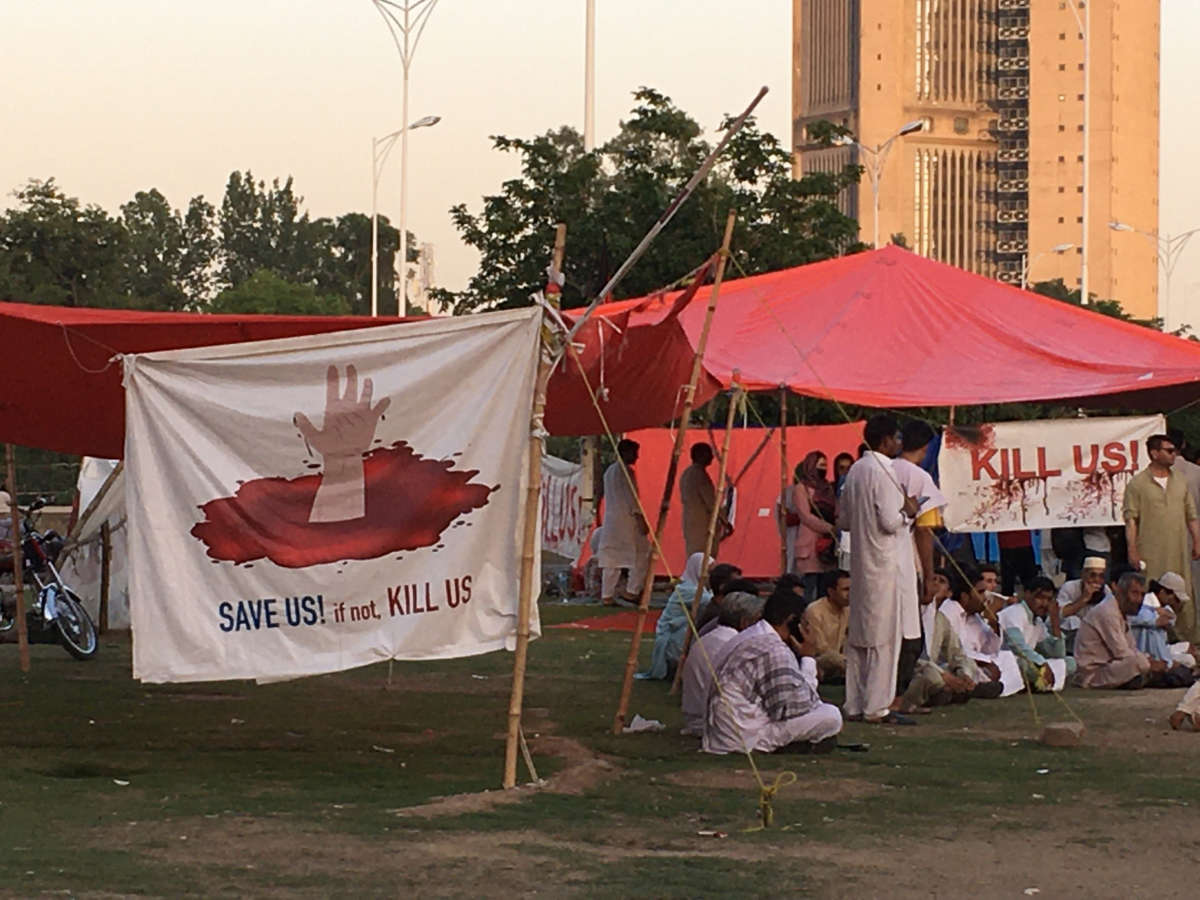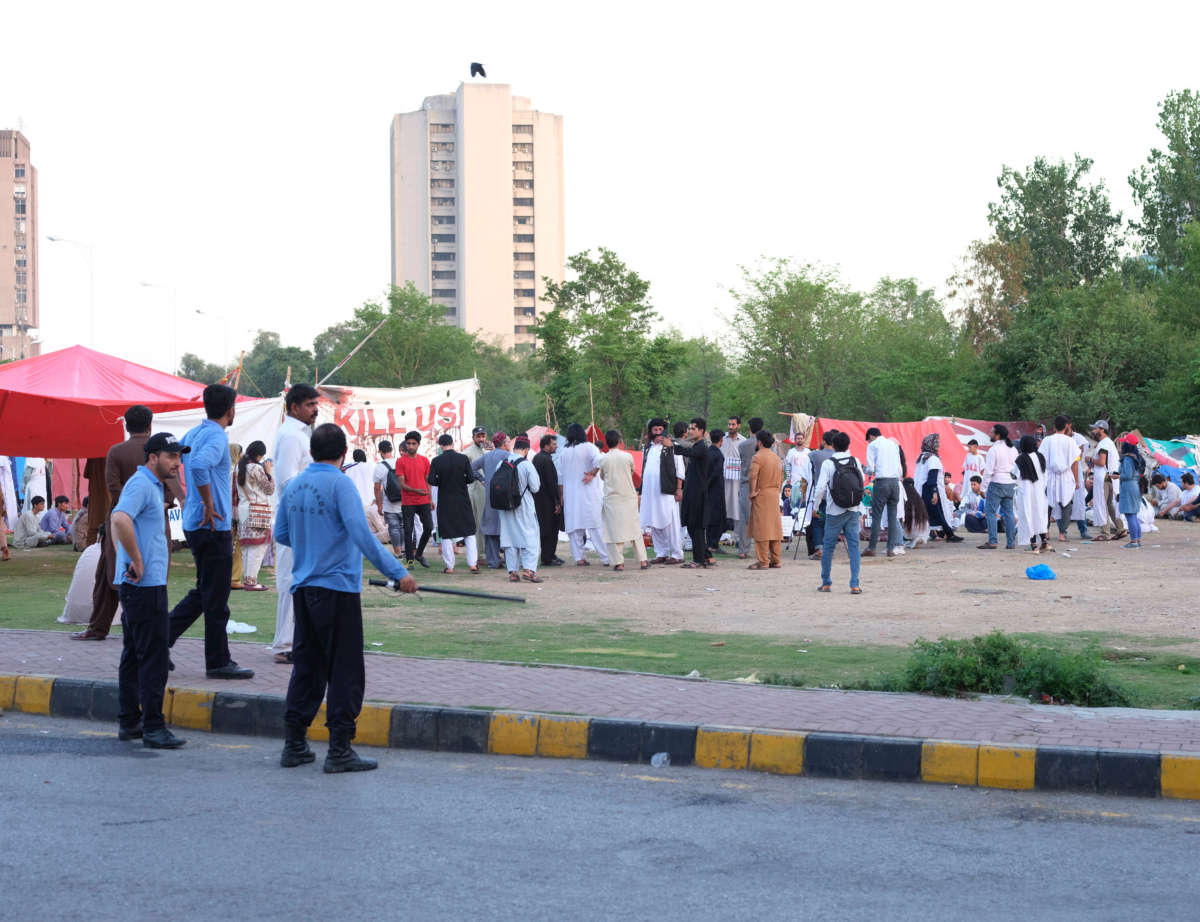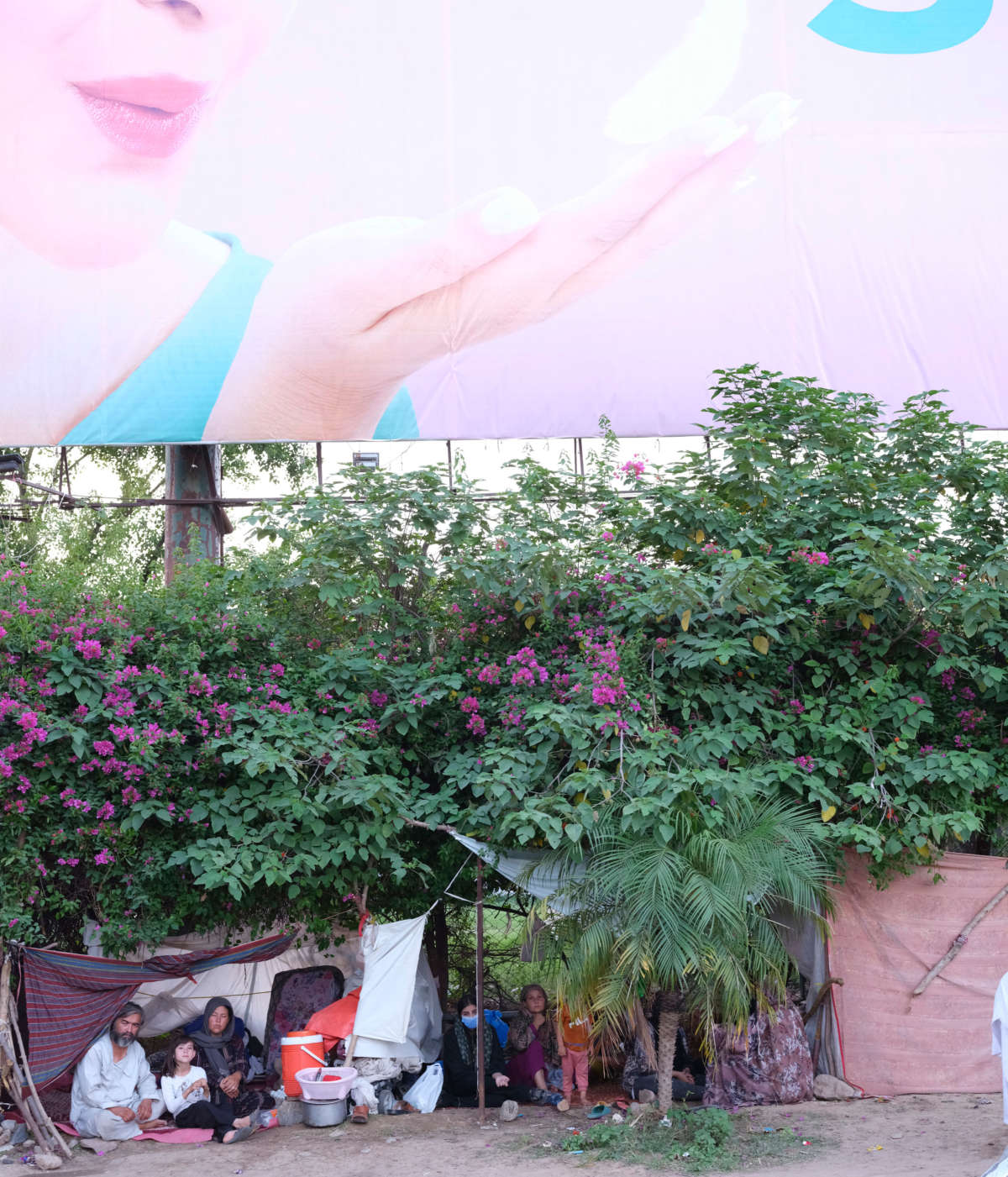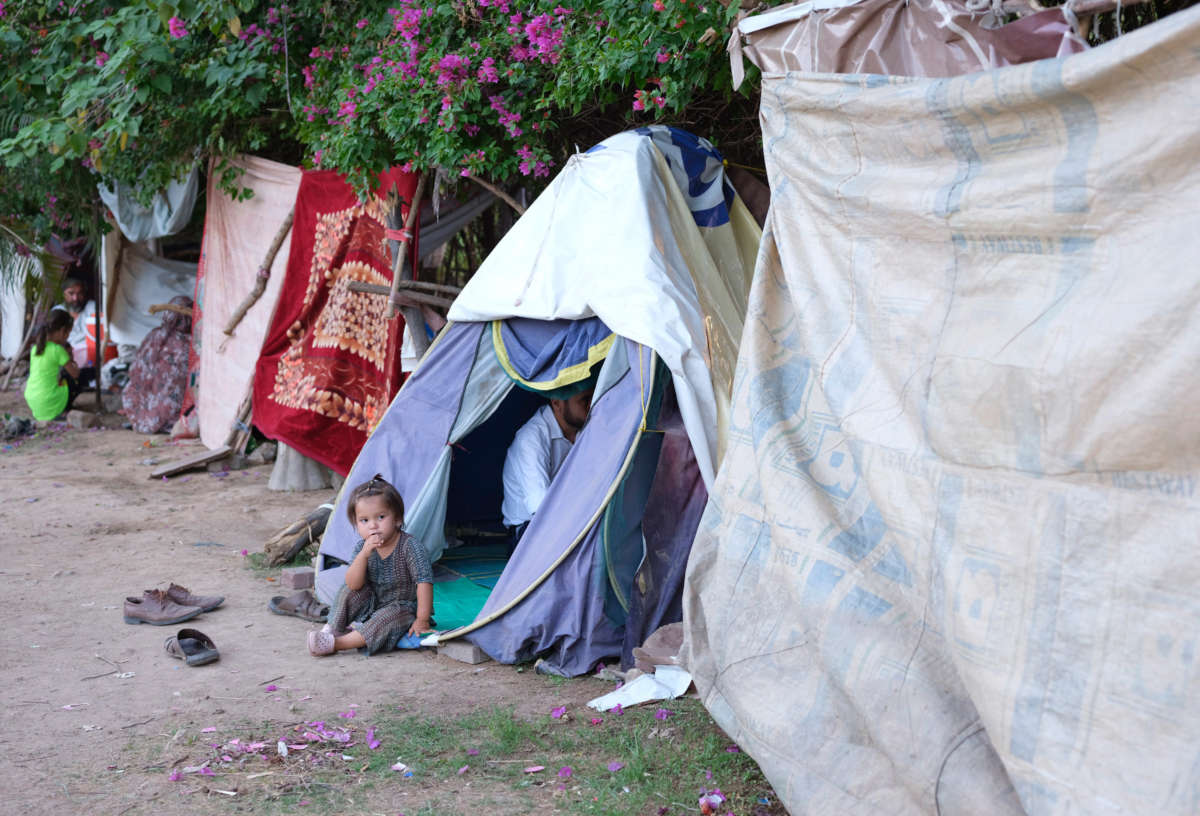On a bare stretch of land near the National Press Club in Islamabad, Pakistan, a collection of tarps and tents serves as shelter for an untold number of Afghan refugee families. Afghans camped here say they have been waiting months to be registered as refugees, and for a chance at humanitarian parole or asylum in other countries. Islamabad’s winter temperatures sink to the upper 30s (Fahrenheit). When I visited in June, temperatures rose frequently to 110 degrees.
In the middle of the encampment, a white sheet suspended between stakes features a painting of a disembodied hand reaching up from a pool of blood above the words “Save Us! If not, Kill Us!” Given the United States-led coalition’s many incidents of unaccountable violence against Afghan civilians, you’d be forgiven for thinking the slogan was a summation of the U.S.’s 20-year Afghan war effort, rather than an expression of the refugees’ desperation.
The encampment is both a protest and a survival strategy for the refugees, who lack work authorization and have nowhere else to go. Benesh* is an Afghan women’s activist who lives in the camp. She relies on donated food and misses meals so her five kids can eat. She is one of many Afghan refugees who fear they could be forced back to Afghanistan and into the hands of the Taliban or other armed groups that are attacking civilians.
Pakistan does not recognize Afghans as refugees. It issues temporary visas that require Afghans to obtain new exit and entry stamps every couple of months. Since other governments have not been eager to grant visas to Afghan refugees, those stuck in Pakistan can legally only get new entry stamps by crossing back into Afghanistan.

Farah’s* story illustrates the danger this poses. She fled from Afghanistan to Pakistan in late 2021, leaving behind her abusive family. Early this spring, she needed to renew her exit and entry stamps. This meant going back to Afghanistan, where the Taliban was demonstrating its new “moderate” worldview by shutting down domestic violence shelters and sending survivors to their abusers.
Dina*, an Afghan woman activist who fled to Pakistan in late 2021, has managed to stay in touch with Farah since then. Farah had asked Dina to accompany her to the border to get the stamps, but “due to security issues for myself, I could not go.” Dina shared what happened next. On the Pakistan side of the border crossing, Farah received her exit stamp. In Afghanistan, Taliban border guards asked her why she was traveling with no mahram, or male guardian. They beat her and then jailed her for days until she agreed to follow the mahram rule. Afterward, they sent her back to her family. She is now trapped in Afghanistan with her abusers. “I really want to help her,” Dina said.
According to the United Nations Committee Against Torture, authorities that turn domestic violence victims over to their abusers are accountable for the abusers’ violence under the UN Convention against Torture and Other Cruel, Inhuman or Degrading Treatment or Punishment.
We can probably assume the Taliban cares little about this finer point regarding their responsibility under international law. But it would help Afghan women refugees if other countries’ migration policies didn’t put them at risk of returning to violence. As Farah’s story illustrates, policies like Pakistan’s entry-stamp requirements can facilitate torture and cruel, inhuman and degrading treatment.
While Pakistan should sign and ratify the UN Refugee Convention, and Iran should halt its ramped-up deportations of Afghans, Afghanistan’s direct neighbors are not the only countries that place refugees in danger. Conditions for Afghans in Pakistan and Iran have not been easy, yet the two countries received the majority of Afghan refugees over the last four decades. Pakistan has regularly been the largest or near-largest host of all refugees globally. It hosted an estimated 3 million Afghans prior to 2021.
Then-Prime Minister Imran Khan proposed in 2018 to grant hundreds of thousands of them citizenship, but the idea died under the weight of military and political opposition. Sixty-two percent of the Afghans that fled to neighboring countries since the start of 2021 went to Pakistan, and close to 38 percent went to Iran. Both Iran and Pakistan face soaring poverty rates and economic crises worsened by the pandemic, and in Iran’s case, by sanctions.
Meanwhile, wealthy governments — including those like the U.S., which instrumentalized Afghan women and girls’ rights to justify invading, bombing and occupying Afghanistan for two decades — have failed to ensure a fully functioning global protection system for Afghan refugees. These governments’ refusal to quickly open their doors to larger numbers of Afghans is leaving women, girls and other persecuted people at risk of being turned over to those they are fleeing. Not to mention there are still countless gender violence victims, human rights defenders, and other vulnerable people in Afghanistan awaiting the chance at resettlement elsewhere in the face of threats and great danger.

As of February 2022, the U.S. had resettled around 65,000 of the Afghans it evacuated during its military withdrawal. It was slow to act before August 2021, however, and is now moving at a glacial pace. Despite calls to speed up the process in the face of the then-impending Taliban takeover, the U.S. only resettled 85 Afghan refugees from January to August last year. U.S. Citizenship and Immigration Services (USCIS) has yet to resolve most of the more than 46,000 applications it received for humanitarian parole from Afghans since last summer. Currently, its website says that it is “receiving an extremely high number of requests for parole” and that processing times, normally 90 days, “may take several months.”
This will not work for the tens of thousands of Afghans with expiring visas in Pakistan. It remains to be seen if resources for faster humanitarian parole processing will be allocated as rapidly as Congress approves $838.8 billion in Pentagon spending ($37 billion more than the military requested). Also in question is the U.S.’s willingness to approve the Afghan humanitarian parole cases it does process.
USCIS rejected more than 93 percent of the mere 4,543 cases it managed to process by the beginning of June this year. A lawsuit filed by the American Civil Liberties Union of Massachusetts stated that this is because USCIS started imposing stricter standards for Afghan applicants last year. Meanwhile, it loosened requirements and waived fees under a humanitarian parole process created specifically for Ukrainians. Following criticism, the Biden administration released new internal guidance for USCIS adjudicators in June. The guidance expands possible forms of evidence to sustain a humanitarian parole case, and widens eligibility to include those from a “targeted group,” members of which face threats of “serious harm.” According to immigration attorneys, whether this will improve acceptance rates for Afghans will depend on how USCIS’s adjudicators enforce the new guidance. Applicants may have to overcome apparent agency bias, as the U.S. Department of Homeland Security has justified high denial rates by asserting that Afghans seek permanent resettlement while Ukrainians want a temporary safe haven.
The European Union has proven not much better at responding humanely. In August 2021, the Austrian interior minister, perhaps not having had a chance to read the news, said he couldn’t imagine a “reason why an Afghan should now come to Austria.” Other EU leaders expressed similar views. While some acknowledged a moral obligation to help Afghan refugees, they ultimately coalesced around a plan, akin to that voiced by the U.S., that largely keeps Afghan refugees in transit countries like Turkey, Iran and Pakistan. Supposedly this would involve providing those countries enough resources to host the refugees — something that never happened in four decades of Afghan refugee crises.

Likely aware that persistent underfunding is the mainstay of humanitarian appeals globally, the neighboring countries’ leaders expressed opposition to the idea. No one listened, and the predicted outflow of Afghan refugees landed largely in their borders. Small numbers of Afghan refugees have been able to trickle out on the rare charter flight to places like the EU, but tens of thousands remain in precarity. Many face the prospect of being returned to danger — not to mention to a country where almost half the population faces acute hunger.
If the plan was to improve Afghanistan’s economy enough to encourage return of those for whom poverty may be a main push factor, the U.S.’s freezing of the Afghan Central Bank’s currency reserves and seizure of half for 9/11 victims has not helped. According to UN independent experts, “overly broad” U.S. sanctions compliance rules are exacerbating “the climate of uncertainty among … banks, businesses and humanitarian donors … preventing people of Afghanistan from any access to basic humanitarian goods.” While aid alone can’t solve these crises, it is still critically needed. As of June 2022, the overall Humanitarian Response Plan of $4.44 billion for Afghanistan was only 32 percent funded. In Pakistan, where most Afghan refugees have fled, the UN Refugee Agency’s operations appeal was still 26 percent unfunded as of July.
Back at the encampment in Islamabad, women’s activist Benesh described her organizing and the reasons she fled to Pakistan. At age 15, she began using her home as a classroom to help Afghan girls catch up on reading and math. Her family had just returned to Afghanistan from exile in the wake of the 2001 U.S. invasion. Later on, she created women’s economic empowerment projects and advocated for women’s rights. She faced periodic threats from Taliban members for this work. In 2021, things became much worse.
In the lead up to their takeover in August 2021, Taliban members killed Benesh’s brother. Her mother died in ISIS-K’s suicide bombing at the Kabul airport that month. She and her daughter endured beatings as they participated in women’s demonstrations that September against Taliban policies. Fellow women protesters were detained and even killed. When Taliban fighters came to her neighbor’s house looking for her, she knew she and her family had to flee. Living for months now in the camp with no income opportunities, she hopes for permanent resettlement so she and her family can rebuild their lives.
“I ask of the world, and of every women’s human rights activist, please don’t forget us. Please help us,” she told Truthout.
* Name has been changed for safety.
Media that fights fascism
Truthout is funded almost entirely by readers — that’s why we can speak truth to power and cut against the mainstream narrative. But independent journalists at Truthout face mounting political repression under Trump.
We rely on your support to survive McCarthyist censorship. Please make a tax-deductible one-time or monthly donation.
